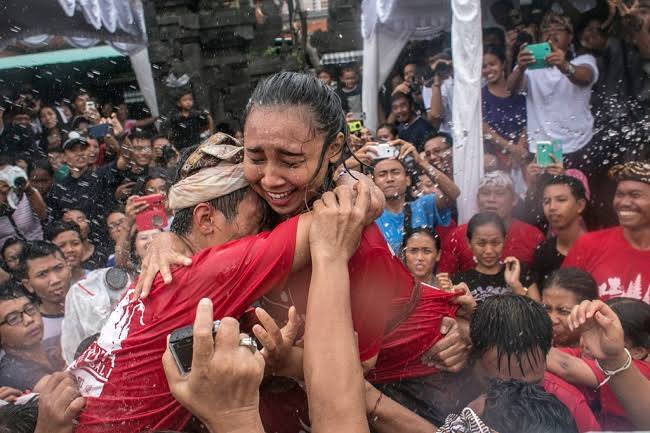Gebug Ende is a unique tradition practiced by the people of Seraya Village in Karangasem Regency, Bali. It serves both as a ritual to invoke rain and as a traditional folk game.
This practice is performed by adult men and children alike, especially during the dry season and after completing their agricultural work.
The ritual employs two primary tools: the “gebug,” a long rattan stick used for striking, and the “ende,” a round shield woven from dried cowhide, used for defense.
The tradition traces its roots back to a battle between the Karangasem Kingdom and the Selaparang Kingdom.
The warriors from Seraya, Angantelu, and Bubug villages fought under Karangasem’s banner and emerged victorious when heavy rainfall disrupted the enemy’s forces—a phenomenon they believed was divine intervention from Hyang Widhi.
Upon returning home, they found Seraya suffering from prolonged drought.
Remembering their fortunate encounter with rain during battle, they performed a ceremonial combat reenactment as an offering to Hyang Widhi, seeking rainfall. Over time, this practice evolved into an enduring cultural tradition.
During the Gebug Ende ritual, participants wear traditional Balinese attire in red, yellow, green, and gold colors.
The game takes place in an open, level area, divided into two sections—one for the participants and the other for spectators.
The ritual begins with prayers for the event’s smooth execution and blessings for the community’s prosperity.
A formal greeting and guidance from the organizers precede the competition. A referee oversees the matches, ensuring fair play.
The sequence starts with young boys, followed by adult men. The fundamental rule is that strikes can only be aimed between the waist and the head. The match ends when one participant is unable to continue.
Accompanied by traditional Balinese musical instruments such as “ceng-ceng,” “suling,” “kempul,” “tawak-tawak,” and “gong kebyar,” the battle-like performance captivates the audience.
The event also includes dramatic expressions of joy, as combatants, despite sustaining bruises or even bleeding, continue to fight with enthusiasm. The belief persists that if blood is shed, rain is more likely to fall.
Seraya Village, located approximately 10 kilometers from Amlapura city, is geographically arid, often facing water shortages during the dry season.
Despite access to piped water, residents still require additional water supplies for daily use.
The community is known for its resilience and strength, characteristics reflected in their traditions.
Gebug Ende is typically held during the dry season, particularly between October and November, aligning with agricultural cycles.
Farmers take part in the ritual during breaks from their work, reinforcing the belief that rain will follow soon after. While rainfall is not guaranteed, the ritual is regarded as a sincere plea to the divine.
Gebug Ende is not the only traditional combat-related event in Karangasem. Other cultural battles include “Teteran” (fire war) in Jasri Village, “Jempana War” and “Banana Leaf Battle” in Bugbug Village, “Banana Fruit Battle” in Tenganan Dauh Tukad, and “Mekare-kare” (thorny pandanus battle) in Tenganan Pegringsingan, a Bali Aga (indigenous Balinese) village.
Beyond Bali, a similar practice called “Presean” exists in Lombok, West Nusa Tenggara.
While both traditions involve combat-style performances to invoke rain, the shields differ in shape: Lombok’s is rectangular, whereas Seraya’s is circular.
Interestingly, a village named Seraya also exists in Lombok, sharing historical ties with the Balinese Seraya.
Due to its unique nature, Gebug Ende has gained recognition beyond its traditional setting.
It is now showcased at cultural festivals, including those catering to domestic and international tourists.
However, community leaders emphasize that the ritual must remain authentic and not be staged for entertainment, as doing so could result in misfortune for the participants.
Artists like Ni Wayan Kinten have even transformed Gebug Ende into a dramatic dance performance while retaining its cultural integrity.
Simple yet deeply symbolic, the ritual continues to reflect the resilience and spiritual devotion of Seraya’s people, ensuring that this ancient tradition endures for generations to come. (BT)
Image Source: Instagram @serayaculturefest





